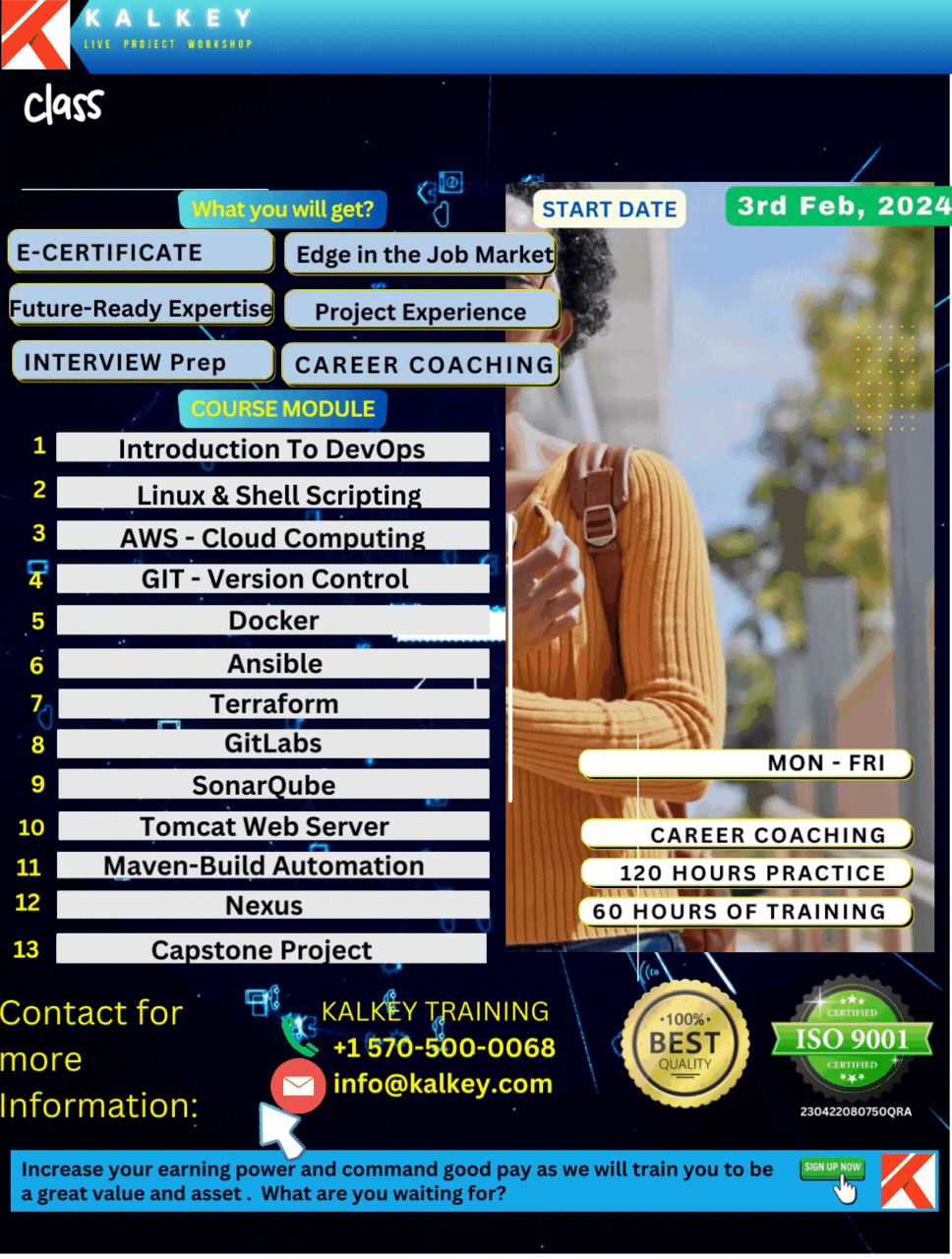Learning Outcomes:
- Over 60 hours of training and 120 hours of practice in a live project
- LIVE PROJECT End to End Automation implementation with cloud, Patching, and troubleshooting Training Included.
- Learn DevOps and cloud (AWS) Automation basics from a professional trainer from your own lab.
- Information-packed practical training starting from basics to advanced DevOps with cloud Automation techniques.
- Best suitable for beginners to advanced level users who learn faster when demonstrated.
- Course content is designed by considering current DevOps and cloud technology and the job market.
- Practical assignments (type-1) of 2 hours at the end of every day’s session.
- Practical assignments (type-2) of 3 hours at the end of every week module.
- The practical learning experience with live project work and examples.
Prerequisites:
- One AWS personal account for setting up the DevOps lab
Course Modules
LINUX Basics & Script
- Top 50 commands used in Linux
- Linux File system structure
- Basic Linux/Unix commands
- Changing file permissions and ownership
- Filter commands
- Simple filter and advanced filter commands
- Start and stop services
- Find and kill the process with id and name
- Package installation using RPM and YUM
- Shell scripts
Introduction to Cloud Computing:
- What is cloud computing?
- Characteristics of cloud computing
- Cloud implementation models
- Cloud service models
- Advantages of cloud computing
- Concerns about cloud computing
AWS:
- Creating AWS account
- Free tier Eligible services
- Understanding AWS Regions and availability zones
EC2 (Elastic Cloud Compute)
- About EC2 and types, Pricing o EIP (Elastic IP address), Allocating, associating, releasing
- Launch Windows and Linux Instances in AWS
- Connecting Windows and Linux instances from Windows desktop and Linux machines
S3 (Simple Storage Service)
- About AWS Storage services, EBS and S3
- Creating S3 Buckets and putting objects in the bucket
- S3 Pricing
- About S3 glacier
EBS (Elastic Block Storage)
- Types of EBS Volumes
- Creation, attaching, and Detaching volumes
ELB (Elastic Load Balancer)
- Understanding the load balancing
- Configuring ELB and adding the webservers under ELB
Auto Scaling
- Types of Scaling (Horizontal and Vertical)
- Configuring Launch Configuration
- Creating and defining the auto-scaling group policy
IAM (Identity Access Management)
- Understanding of AWS Security using IAM
- Definition of Roles, policies, and Groups
- Creating IAM Users and managing password policies
RDS (Relational Database server)
- About RDS and available RDS Engines in AWS
- Configuring the MYSQL RDS service
- Connecting EC2 Instance to RDS Instance
Elastic Beanstalk
- Deploying Apps and RDS Connection
- Updating Configurations and deployments
- Systems Manager Parameter.
Introduction to DevOps
- What is Software Development
- Software Development Life Cycle
- Traditional Models for SDLC
- Why DevOps?
- What is DevOps?
- DevOps Lifecycle
- DevOps Tools
- What is Software Development
- Software Development Life Cycle
- Traditional Models for SDLC
- Why DevOps?
- What is DevOps?
- DevOps Lifecycle
- DevOps Tools
Software Version Control
- What is Version Control
- Types of Version Control Systems
- Introduction to SVN
- Introduction to Git
- Git Lifecycle
- Common Git Commands
- Working with Branches in Git
- Merging Branches
- Resolving Merge Conflicts
- Git Workflow
Build Automation
- Introduction with Maven
- Maven Structure and Phases
- Installation of Maven
- Configuration
- jar/war project structure
Tomcat Web Server
- Installation and Configuration
- Tomcat Manager
- Application Management
- App Deployment Methods
SonarQube
- Installation
- Integration
- Code Analyzing
Nexus Artifacts Tool
- Introduction to Nexus
- Installation and Configuration
- Repository Management
- Proxy Management
- Integration with Maven
Ansible:
- Introduction to Ansible.
- Configuration, Ansible Playbooks
- Ansible-Based Configuration Management
- Different Roles
- Command Line usage
Terraform:
- Terraform Introduction and use
- Terraform Installation in Windows and Linux
- Terraform and EC2 integration
- Interpolation, Attributes, and Variable
- Terraform Provisioners
- Terraform Modules and Workspaces
- Terraform State
Working with Docker:
- Introduction to Docker
- Docker Terminologies
- Installation of Docker
- Docker image creation and Docker deployment.
- Docker administration
- Docker Swarm
Working with Kubernetes:
- Kubernetes Fundamentals and Architecture
- Application Deployment and Resource Management
- Networking and Storage in Kubernetes
- Security Best Practices in Kubernetes
- Monitoring and Troubleshooting
- High Availability and Cluster Maintenance




